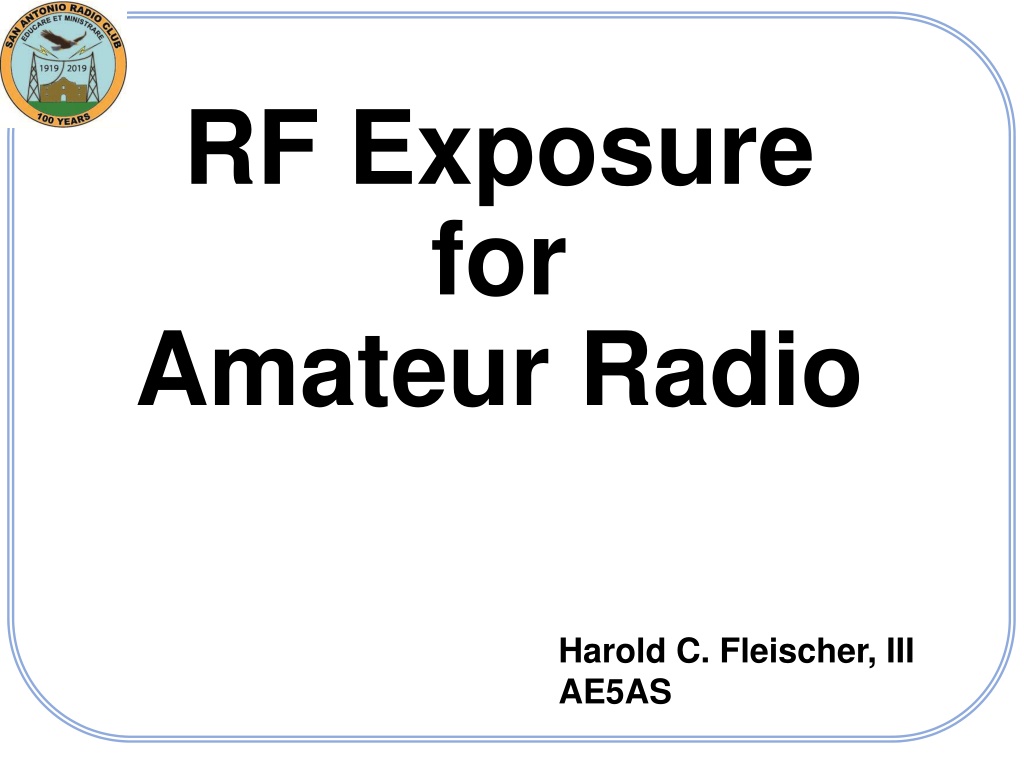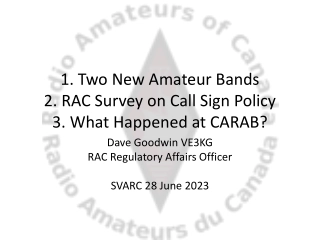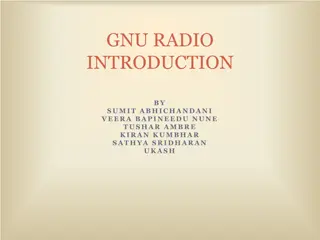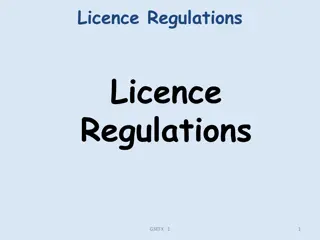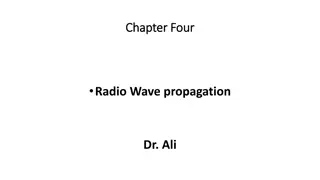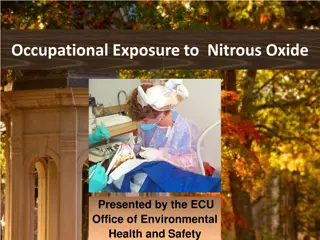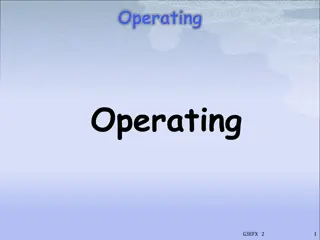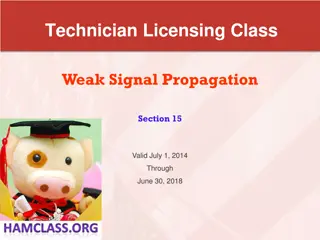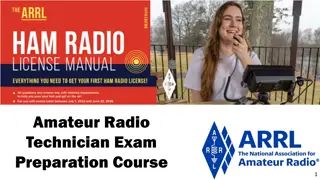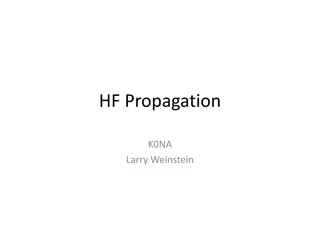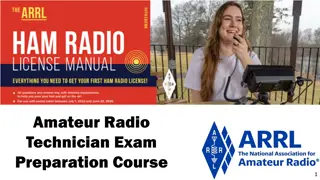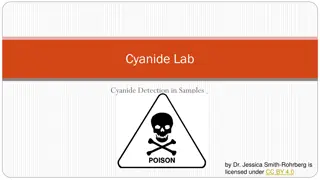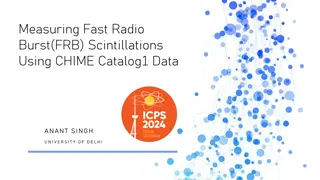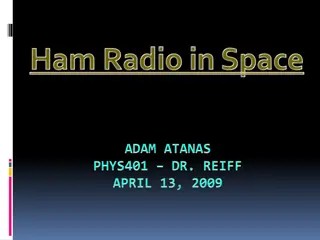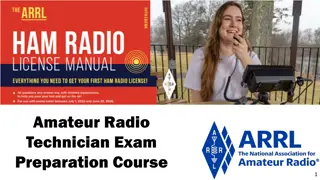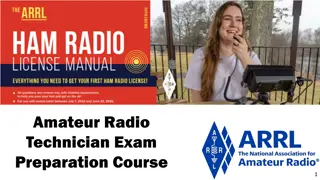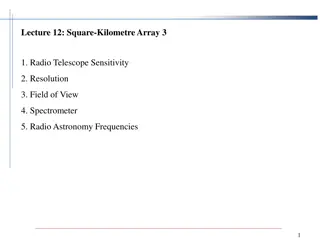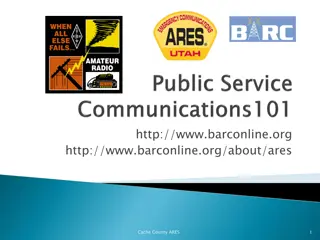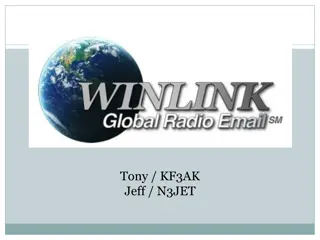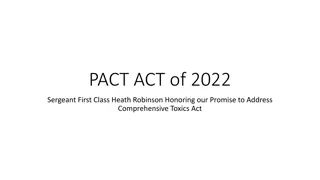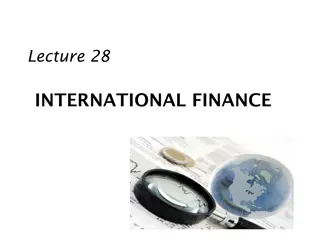RF Exposure for Amateur Radio: Understanding Sources and Safety Measures
Exploring the various sources of RF exposure in relation to amateur radio, this comprehensive guide by Harold C. Fleischer, III AE5AS sheds light on different antennas like those used by AM, FM radio stations, TV stations, MW telecommunications, police, taxis, and even Wi-Fi routers. Each image showcases a different type of antenna, helping readers understand the potential health risks and safety precautions associated with RF exposure. It serves as a valuable resource for amateur radio enthusiasts looking to minimize their exposure to electromagnetic radiation.
Download Presentation

Please find below an Image/Link to download the presentation.
The content on the website is provided AS IS for your information and personal use only. It may not be sold, licensed, or shared on other websites without obtaining consent from the author. Download presentation by click this link. If you encounter any issues during the download, it is possible that the publisher has removed the file from their server.
E N D
Presentation Transcript
RF Exposure for Amateur Radio Harold C. Fleischer, III AE5AS
RF Exposure Sources Is this a Ham Radio Antenna? 2 10/9/2024 RF Exposure
RF Exposure Sources NO. It is an AM Radio Station Antenna. 3 10/9/2024 RF Exposure
RF Exposure Sources AM Is this a Ham Radio Antenna? 4 10/9/2024 RF Exposure
RF Exposure Sources AM NO. It is an FM Radio Station Antenna. 5 10/9/2024 RF Exposure
RF Exposure Sources FM AM TV 6 10/9/2024 RF Exposure
RF Exposure Sources FM AM TV MW Telecommunications 7 10/9/2024 RF Exposure
RF Exposure Sources FM AM TV MW MW MW MW POLICE 8 10/9/2024 RF Exposure
RF Exposure Sources FM AM TV MW MW MW MW TAXI POLICE Commercial 9 10/9/2024 RF Exposure
RF Exposure Sources FM AM TV MW MW MW MW CELL TAXI POLICE 10 10/9/2024 RF Exposure
RF Exposure Sources FM AM TV MW MW MW MW CELL TAXI POLICE 11 10/9/2024 RF Exposure
RF Exposure Sources FM AM TV MW MW MW MW CELL TAXI POLICE 12 10/9/2024 RF Exposure
RF Exposure Sources FM AM TV MW MW MW MW CELL TAXI POLICE 13 10/9/2024 RF Exposure
RF Exposure Sources FM AM TV MW MW MW MW CELL TAXI POLICE WI-FI Router 14 10/9/2024 RF Exposure
RF Exposure Sources FM AM TV MW MW MW MW WI-FI Rout er CELL TAXI POLICE Amateur Radio 15 10/9/2024 RF Exposure
RF Exposure Sources FM We live in a world awash in RF energy. AM TV MW MW MW MW WI-FI Rout er CELL TAXI POLICE Amateur Radio 16 10/9/2024 RF Exposure
RF Energy and Exposure Can RF Exposure be dangerous? Yes (Microwave oven for one example) Can contact with RF antennas transmitting a lot of watts be dangerous? Yes, RF burns are possible if you touch antennas while they are transmitting a lot of power. Can I be safe? Yes, regulatory agencies have a lot of data on RF energy and what is safe. As a Licensed Amateur Radio Operator you are obligated to be safe by our regulator, FCC. 17 10/9/2024 RF Exposure
FCC 18 10/9/2024 RF Exposure
FCC 19 10/9/2024 RF Exposure
FCC 20 10/9/2024 RF Exposure
Office of Engineering and Technology (OET) This organization manages spectrum. They assign frequencies to specific purposes or bands. They create the rules on location and separation of transmitters. This organization does the technical studies as to how much RF energy exposure is acceptable for human beings. They work with various technical organizations in analyzing data. They work with international bodies. OET Bulletin Number 65 sets standards on RF Exposure. 21 10/9/2024 RF Exposure
OET Bulletin Number 65 Evaluating Compliance with FCC Guidelines for Human Exposure to Radiofrequency Electromagnetic Fields This is the title Very technical, but it has to be. Not something the average person would want to do. 22 10/9/2024 RF Exposure
Amateur License Application Form 605 23 10/9/2024 RF Exposure
Amateur License Application Form 605 Your Signature 24 10/9/2024 RF Exposure
Amateur License Application Form 605 Your Signature This is what you signed! You will comply with RF Exposure rules! 25 10/9/2024 RF Exposure
What must Amateur Radio Licensed Operator do for RF Exposure? Basically, you must know how far to put antennas from: People who know the antenna is there Controlled Environment People who do not know the antenna is there Uncontrolled Environment Hand Transceivers with low power, 5 watts, are not an issue and presumed safe. 26 10/9/2024 RF Exposure
Recommendation Use Tools at ARRL Website www.arrl.org/rf-exposure Various, good references ARRL technical information FCC RF Exposure Resources Links to ARRL articles on RF safety ARRL s RF Exposure Calculator 27 10/9/2024 RF Exposure
Recommendation Use Tools at ARRL Website http://www.arrl.org/rf-exposure www.arrl.org/rf-exposure Various, good references ARRL technical information FCC RF Exposure Resources Links to ARRL articles on RF safety ARRL s RF Exposure Calculator 28 10/9/2024 RF Exposure
RF Exposure Calculator Basic Operation Put in parameters for your amateur radio operation including antenna Parameters are: Power in Watts Mode duty cycle Transmit duty cycle (time transmitting) Antenna gain dBi Operating Frequency Include Effects of Ground Reflection Push the Calculate Button Record Results The FCC requires you to know the RF Exposure for your amateur radio station. 29 10/9/2024 RF Exposure
Power at Antenna Parameter Legal values 160M, 80M, 40M, 20M, 17M, 15M, 12M, 10M, 6M, 2M, 70CM 1-1500 Watts 60M 100 Watts 30M 200 Watts Most HF transmitters are limited to 100 Watts Most mobile 2M and 70CM will be 25-50 Watts If you have an amplifier, use the highest PEP Watts for that amplifier 30 10/9/2024 RF Exposure
Mode Duty Cycle Parameter Choices are: Conversational SSB, no speech processing (20% duty cycle) Conversational SSB, heavy speech processing (50% duty cycle) Conversational CW (duty cycle 40%) FM (duty cycle 100%) AM (duty cycle 100%) FSK/RTTY (duty cycle 100%) AFSK SSB (duty cycle 100%) Carrier Always On, i. e., for Tuning Up (duty cycle 100%) For all others, or for unknown, assume worst case (duty cycle 100%) Most amateur radio operators doing voice over SSD will use the first choice Conversational SSB, no speech processing 31 10/9/2024 RF Exposure
Transmit Duty Cycle Parameter Transmit parameter is between 1 30 minutes Receive parameter is between 1 30 minutes Unless you are running a pile-up, you are spending more time listening then talking Probably, 5 minutes transmitting followed by 10 minutes receiving overstates most operator encountered conditions and is more on the worst case side. 32 10/9/2024 RF Exposure
Antenna Gain Parameter If you bought an antenna and it has a dBi rating in its documentation, use that. If you have a meter to measure gain and have done that, use that. In other cases, use the ARRL reference table for antennas. The three most common are: Quarter wave vertical 1.15 dBi Half wave dipole 2.15 dBi Three element yagi 8.1 dBi Others include yagis with a different number of elements, G5RV, Hex Beam, Delta Loop, etc. 33 10/9/2024 RF Exposure
Include Effects of Ground Reflections Parameter Ground Effects pretty much are always present unless the antenna is a wave length above the ground. Generally, the worst case (more safety) is to check this parameter. Recommend you always check this parameter. 34 10/9/2024 RF Exposure
RF Exposure Results for 100W Mode Duty Cycle Controlled Uncontrolled Controlled 100 SSB, 20% 0.2272 0.2035 100 SSB, 20% 0.284 0.4017 100 SSB, 20% 0.4058 0.5739 100 SSB, 20% 0.5415 0.7658 100 SSB, 20% 0.7668 1.0845 100 SSB, 20% 1.0736 1.5182 100 SSB, 20% 1.3722 1.9406 100 SSB, 20% 1.6075 2.2733 100 SSB, 20% 1.8889 2.6713 100 SSB, 20% 2.185 100 SSB, 20% 2.2721 3.2132 100 FM, 100% 5.0805 7.185 100 FM, 100% 4.2192 5.9668 Transmit 5 min, Receive 10 min. Ground Effects Included Feet Power Watts Vertical 1.5 dBi Dipole 2.15 dBi Beam 8.1 dBi Center MHz Uncontrolled Controlled 0.2193 0.4329 0.6185 0.8253 1.1687 1.6362 2.0914 2.45 2.8788 3.4629 3.4629 7.7433 6.4304 Uncontrolled 0.04351 0.8587 Band 160M 80M 60M 40M 30M 20M 17M 15M 12M 10M 6M 2M 70CM 1.9 3.75 0.2449 0.3061 0.4374 0.5836 0.8264 1.157 1.4788 1.7324 2.0356 2.4486 2.4486 5.4753 4.547 0.858 0.6072 0.8677 1.1577 1.6395 2.2952 2.9337 3.4368 4.0383 4.6714 4.8576 10.862 9.0204 5.3585 7.15 10.125 14.175 18.118 21.225 24.94 28.85 1.227 1.6373 2.3185 3.2459 4.1489 4.8603 5.711 6.6064 6.8697 15.3612 12.7568 3.09 52 146 435 Key points: 1. If antenna is 18 off of the ground, no problems on any of these bands. 2. If 6M-160M antennas are 8 off of the ground, no problems on those bands. 35 10/9/2024 RF Exposure
RF Exposure Results for 1500W Mode Duty Cycle Controlled Uncontrolled Controlled 1500 SSB, 20% 0.88 1500 SSB, 20% 1.1 100 SSB, 20% 0.4058 1500 SSB, 20% 2.0973 200 SSB, 20% 1.0845 1500 SSB, 20% 4.1579 1500 SSB, 20% 5.3145 1500 SSB, 20% 6.2258 1500 SSB, 20% 7.3155 10.3457 1500 SSB, 20% 8.4624 11.9677 1500 SSB, 20% 8.7997 12.4447 1500 FM, 100% 19.6768 27.8272 1500 FM, 100% 16.3407 23.1093 Transmit 5 min, Receive 10 min. Ground Effects Included Key point: If 6M-160M antennas are 18 off of the ground, no problems on those bands for verticals and dipoles. The 17M-160M beams are okay as well. Feet Power Watts Vertical 1.5 dBi Dipole 2.15 dBi Beam 8.1 dBi Center MHz Uncontrolled Controlled 0.8494 1.6765 0.6185 3.1965 1.6528 6.337 8.0998 9.4888 11.1496 12.8976 13.4117 29.9896 24.905 Uncontrolled Band 160M 80M 60M 40M 30M 20M 17M 15M 12M 10M 6M 2M 70CM 1.9 3.75 0.7882 1.5556 0.5739 2.966 1.5337 5.8801 7.5158 8.8046 0.9484 1.1854 0.4374 2.2602 1.1687 4.481 5.7274 6.7095 7.884 9.12 9.4825 21.2058 17.6105 1.8814 2.3517 0.8677 4.4839 2.3185 8.8894 11.3621 13.2479 15.6403 18.0923 18.8135 42.0683 34.9358 1.6861 3.3258 1.227 6.3412 3.2789 12.5715 16.0685 18.7353 22.1187 25.5864 26.6063 54.4936 49.4067 5.3585 7.15 10.125 14.175 18.118 21.225 24.94 28.85 52 146 435 36 10/9/2024 RF Exposure
Sensitivity in the RF Exposure Calculator Required separation distances do not vary very much in the same band such that the mid-point frequency is representative. Mode duty type really matters the difference between 20% and 100% is significant. FT8 is treated as 100%. Transmit and receive time durations and ratios matter. Power matters and antenna dBi matters. Effects of Ground Reflection can be seen 37 10/9/2024 RF Exposure
RF Exposure Recommendations If the parameters of each table apply to you use that table as your RF Exposure Study. A number of individuals with 100W HF Transceivers operating SSB Voice can use the 100W table. Anybody using an amplifier operating SSB Voice can use the 1500W table as the worst case. You need to make your own table if: You are doing CW, FSK/RTTY, AFSK SSB, FT8, or some other mode. You are using an antenna type not in the tables. You are using a long transmit times and short receive times. 38 10/9/2024 RF Exposure
References OET Bulletin 65. Evaluating Compliance with FCC Guidelines for Human Exposure to Radiofrequency Electromagnetic Fields. Washington, DC: FCC. (Undergoing revision) RF Exposure and You. Hare, Ed. 1998. Newington, CT: ARRL. (Out of Print, growing obsolete) Chapter 22.3: RF Safety from 2023. The ARRL Handbook for Radio Communications. Newington, CT: ARRL. ARRL RF Exposure Calculator. http://www.arrl.org/rf- exposure-calculator 39 10/9/2024 RF Exposure
